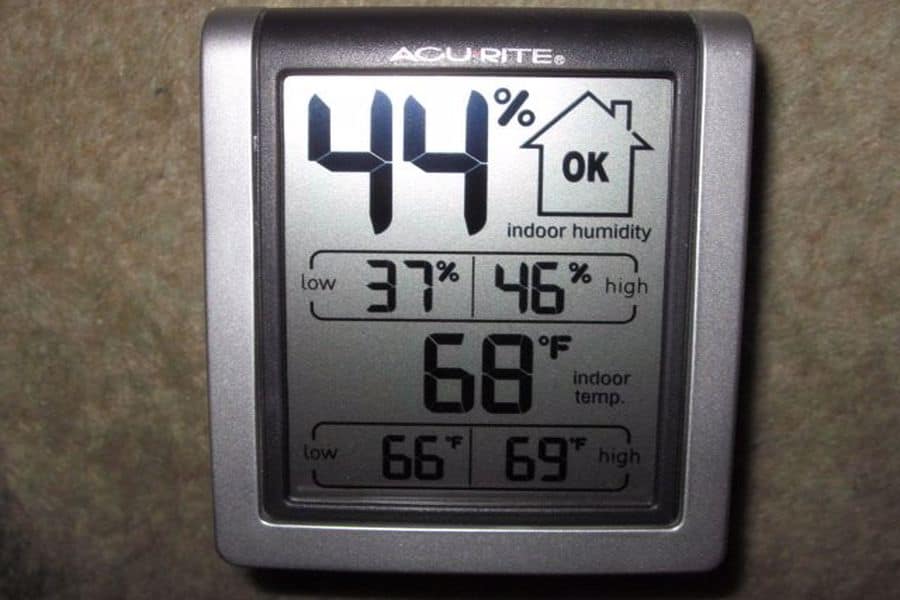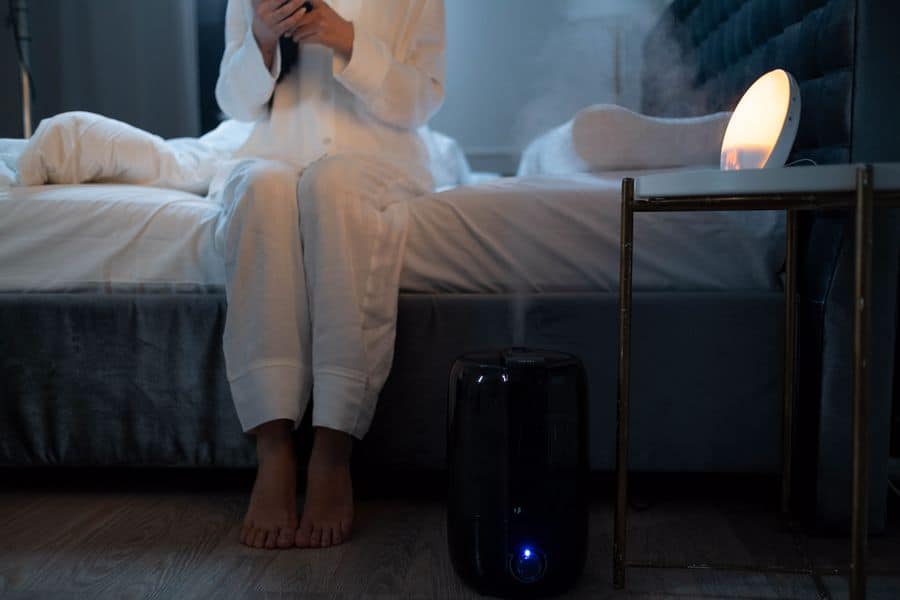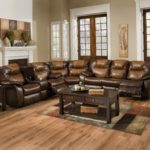If you have ever been to the south or to Florida in the summer for example, you would never caught dead asking what the best humidity level for your home is, or be worried about not enough humidity. But low and behold, once the colder winter months start coming upon you, you start asking yourself about the humidity. That being said, just like being outside, your home will have its own humidity levels as well.
That being said there is a range that is the best humidity level for your home depending on the season and the temperature that will make your interior feel more desirable and is actually good for your home.
If you feel so incredibly dry that you might get a nose bleed in your home during the winter, that might be an indicator that your home has a humidity level that is too low! Thankfully there is a way to combat this dryness, and generally this is used with air humidifiers.
Table Of Contents
- Best Humidity Level For Your Home
- What Happens If Your Humidity Level is Not Ideal?
- How Humidity Level Affects Sleep?
- How to Manage Your Homes Humidity Levels
- Optimal Humidity Level for Home and Bedroom
- Optimal Temperature for Sleeping
- Types of Home Humidifier Systems:
- Final Thoughts on Controlling the Humidity in Your Home
Best Humidity Level For Your Home
To keep this post nice and simple below is the optimal humidity levels during the winter for your homes!

- If the outside temperature is between 20 degrees and 40 degrees then your home should be no higher than 40% humidity.
- If the outside temperature is between 10 degrees and 20 degrees then your home should be no higher than 35% humidity.
- If the outside temperature is between 0 degrees and 10 degrees then your home should be no higher than 30% humidity.
- If the outside temperature is between -20 degrees and 0 degrees then your home should be no higher than 25% humidity.
- If the outside temperature is anywhere below -20 degrees then your home should be no higher than 15% humidity.
In the end of the day it might seem like a difficult task to maintain and manage a humidity level in your home, but once you become conscious of the benefits, then it really is no bother to find the best humidity level for your home.
What Happens If Your Humidity Level is Not Ideal?
If your home isn’t at the ideal humidity level, there are a load of things that will begin to happen that not only affect your comfort level, but can also affect your health.
Humidity Level is Too Low (Winter):
- Leads to Dry and Itchy Skin.
- Makes Your Body More Susceptible to Illness.
- Can Actually Damage Your Hardwoods and Furniture.
Humidity Level is Too High (Summer):
- Leads to Increased Mold Production and Growth.
- Creates a Muggy Condition and Environment in Your Home.
- Can Disrupt Sleep Patterns.
- Leads to Increased Risk of Illness.
How Humidity Level Affects Sleep?
When you sleep, your body goes into three stages of non-rapid eye movement (NREM) and one rapid eye movement stage (REM). The first three stages of NREM readies your body for deep sleep. This will eventually lead to REM.
If you sleep in a humid room, your sleep cycle can be affected. Your body will have to work more when you sleep. Your body needs to regulate its temperature so it will use more energy to keep you warm. You might even wake up from discomfort.
A more humid room may also trigger allergies. The more humid the room, the more likely molds will form that can cause breathing and sleeping discomfort. Hence, it’s important to monitor humidity levels to get a good sleeping experience.
How to Manage Your Homes Humidity Levels
Now that I have talked about the optimal humidity levels in your home, the next steps are focusing on how you can manage your humidity level, and keep it as comfortable as possible. Generally speaking, during summer your home can feel sticky, and during winter it can feel dry. To help alleviate this, there are few options available to you.
Managing Humidity in the Summer:
- Don’t use any humidifiers in your home during the summer.
- Run air conditioners to help remove some of the moisture from the air.
- Use your homes exhaust fans if available. A Honeywell Fresh Breeze is a great option.
Managing Humidity in the Winter:
- Use a room humidifier to help add some moisture to the air.
- Consider adding houseplants. Houseplants add moisture to the air and help to manage a dry and stuffy room!
- Place some water basins near your heating system to add moisture through the heat.
- If you are serious, consider purchasing an entire home humidifier system.

Optimal Humidity Level for Home and Bedroom
An optimal way to measure humidity is relative humidity. You can use a hygrometer to measure humidity. The ideal humidity for indoors is between 40% – 60%. Anything above 60% may not be suitable for comfort. In general, households keep their humidity between 40% – 50%.
Some experts even recommend maintaining between 30% – 50% humidity for a better sleep experience. You don’t want the environment to be too dry or have too much moisture.
Too humid and you might feel too hot and discomfort when sleeping. It’s harder to sleep if you’re in that environment. Too cold and your skin and throat will go dry and you might even catch a cold.
Optimal Temperature for Sleeping
The optimal temperature for sleeping is between 16°C – 18°C (60.8°F – 64.4°F). Rooms should ideally be around 18.5°C – 20.5°C. However, it may be different for you. You should choose the ideal temperature that makes you comfortable sleeping.
The temperature bracket is the common ideal temperature for my circadian rhythm to go to sleep. Other factors may also affect your sleep time and ability to sleep. Examples of these are physical activities, the food I eat, evening routine, and other stuff.
Types of Home Humidifier Systems:
If you are considering purchasing a home humidifier system, then you should know that there are two main type of home humidifier systems. These two types are warm mist humidifiers and cold mist humidifiers.
That being said, the more popular option are cold mist humidifiers because they are more comfortable, and even a little safer.
Benefits of a Cold Mist Humidifier:
As mentioned cold mist humidifiers have all sorts of benefits. One of the main reasons is based purely around comfort. This cold mist system brings more humidity into dry houses, which allows a more comfortable environment.
These systems can be extremely beneficial for those with asthma or a cold. Increasing the humidity in a room helps to open up the nasal passages and keeps them lubricated, which helps them heal and improve sinus health.
Along with this, cold mist humidifiers are a better option than warm mist humidifiers because of safety. Warm mist humidifiers rely on boiling water to create the humidity, but this creates a risk of burning people or pets, which makes the cold mister a better option.
Along with this, cold mist humidifiers actually use less energy that warm mists, which makes it a great overall option.
Final Thoughts on Controlling the Humidity in Your Home
Overall, if you are like me, then in the dead of winter, you’ll be praying for a little more humidity, and in summer you’ll be praying for it to go away. As I discussed earlier, on average the optimal humidity level for your home is around 45%-55%. That being said, by using home humidifiers you can help to manage this level, and make it optimal for your comfort!






